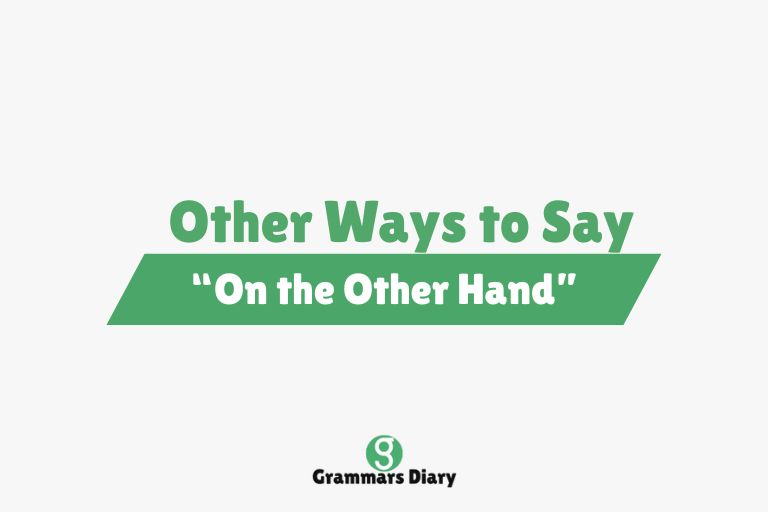“On the other hand” is a familiar phrase we often use when we’re presenting a contrasting viewpoint, offering a different perspective, or balancing two sides of an argument. For instance, someone might say, “He’s a great chef. On the other hand, he struggles with time management.” In this context, it signals a shift in perspective.
But in writing, repetition dulls your style, and using the same transition over and over again can make your message sound flat or robotic. To keep your communication engaging and fresh, it helps to have a range of alternatives ready to use based on your tone, purpose, or audience. This article will walk you through 20 useful alternatives for “on the other hand,” explaining their meanings, giving examples, and highlighting when you should use each one.
Other Ways to Say “On the Other Hand”
1. Conversely
Example: “The team worked hard. Conversely, their competitors seemed unprepared.”
Meaning: Indicates an opposite or reverse situation.
Usage: Often used in formal writing to show contrast clearly and directly, especially in reports or essays.
2. In contrast
Example: “He enjoys early mornings. In contrast, his sister prefers late nights.”
Meaning: Highlights a clear difference between two things.
Usage: Useful in analytical writing or speeches when comparing two ideas or actions with a strong opposing nature.
3. However
Example: “The project was completed on time. However, it went over budget.”
Meaning: Signals a contradiction or unexpected outcome in relation to what was previously stated.
Usage: Common in both formal and informal writing; ideal when softening a contrast or shifting the reader’s perspective.
4. Yet
Example: “She trains daily. Yet, she feels underprepared for the competition.”
Meaning: Shows a surprising or unexpected contradiction.
Usage: Simple and effective in conversational and narrative writing where you want a subtle transition.
5. Alternatively
Example: “You could drive to the event. Alternatively, there’s a train that stops nearby.”
Meaning: Suggests another choice or possibility rather than direct opposition.
Usage: Perfect when offering another option, often used in instructional or advisory content.
6. Still
Example: “He knows the risks. Still, he chooses to proceed.”
Meaning: Introduces a point that remains valid despite what was just said.
Usage: Best in informal writing or speeches when you want to express quiet resistance or persistence.
7. But then
Example: “She could have accepted the job. But then, it would’ve meant relocating.”
Meaning: Softens the contrast, often reflecting hesitation or inner conflict.
Usage: Suitable for conversational writing, personal reflections, or storytelling.
8. Then again
Example: “He might agree to help. Then again, he may be too busy.”
Meaning: Indicates reconsideration or re-evaluation of the previous thought.
Usage: Casual tone; works well in friendly articles, blog posts, or informal commentary.
9. That said
Example: “The meal was a bit expensive. That said, it was absolutely delicious.”
Meaning: Concedes a previous point while introducing an opposing or balancing idea.
Usage: Helpful when trying to sound fair and balanced in discussions or product reviews.
10. Even so
Example: “The offer was tempting. Even so, she declined it.”
Meaning: Emphasizes that despite circumstances, the outcome was unexpected or contrary.
Usage: Works well in thoughtful opinion writing or reflective pieces to show resilience or contrast.
11. Nonetheless
Example: “He lacked experience. Nonetheless, he performed impressively.”
Meaning: Emphasizes contrast despite the circumstances previously mentioned.
Usage: Ideal in persuasive or analytical writing to stress a point that remains valid.
12. Notwithstanding
Example: “Notwithstanding his injury, he completed the race.”
Meaning: Conveys that something happened despite a previous fact or obstacle.
Usage: More formal in tone; often used in legal or academic writing.
13. Then again
Example: “The plan seems solid. Then again, there might be hidden risks.”
Meaning: Reflects a reevaluation or a different point of view after initial agreement.
Usage: Effective in informal conversation or blog writing for a nuanced turn in thinking.
14. In opposition
Example: “The board supports the policy. In opposition, the employees are protesting.”
Meaning: Expresses clear disagreement or resistance.
Usage: Appropriate for political, legal, or organizational contexts where two sides are directly opposed.
15. Rather
Example: “He didn’t ignore the issue. Rather, he waited for the right moment to speak up.”
Meaning: Refutes a previous assumption and replaces it with another viewpoint.
Usage: Well-suited for academic or persuasive writing when clarifying a misinterpretation.
16. Albeit
Example: “He accepted the offer, albeit with some reservations.”
Meaning: Indicates a slight contrast within a sentence.
Usage: Formal and compact—great for essays or commentary with nuanced opinion.
17. Inversely
Example: “As temperature increases, the density decreases inversely.”
Meaning: Describes a relationship where one variable changes in the opposite direction of another.
Usage: Common in scientific, technical, or data-driven writing.
18. Elsewise
Example: “They should follow the guidelines. Elsewise, penalties may apply.”
Meaning: Otherwise or if not—indicates a conditional contrast.
Usage: Archaic but occasionally used for stylistic effect in creative or legal writing.
19. On the flip side
Example: “The weather’s been awful. On the flip side, the plants are thriving.”
Meaning: A casual, friendly way to show contrast or benefit in a bad situation.
Usage: Informal and perfect for blogs, casual content, or relatable storytelling.
20. As a counterpoint
Example: “She praised the film’s direction. As a counterpoint, he criticized the pacing.”
Meaning: A contrasting idea presented to balance or oppose a previous statement.
Usage: Strong in academic essays, discussions, and structured debates.
When to Use Different “On the Other Hand” Alternatives
In Academic or Essay Writing
In structured writing like essays, research papers, or academic articles, formal alternatives such as “conversely,” “in contrast,” “notwithstanding,” or “rather” carry a more polished and intellectual tone, helping you transition logically between complex ideas.
In Professional or Business Settings
In the workplace, clarity and professionalism matter. Phrases like “however,” “alternatively,” “that said,” and “nonetheless” help maintain a respectful, balanced, and diplomatic tone during discussions or written reports where contrast is necessary without sounding dismissive.
In Everyday Conversations
For daily dialogue, friendly blog posts, or social media, go with relaxed expressions like “on the flip side,” “still,” “then again,” or “but then.” These make your tone feel relatable, natural, and easier to follow without sacrificing clarity.
Conclusion
“On the other hand” is a reliable phrase that helps us show contrast or another perspective, but when used too often, it can become repetitive and predictable. By expanding your vocabulary with these 20 alternatives, you not only enhance your expression but also adapt your language to fit different tones, styles, and audiences more effectively.
Whether you’re writing a blog, giving a speech, crafting an email, or simply having a conversation, the right transition phrase can add just the nuance your message needs.
FAQs
What does “on the other hand” mean?
It introduces a contrasting point or perspective, often used to compare two sides of an issue or argument.
Is “on the other hand” formal or informal?
It’s neutral and can be used in both formal and informal writing, but more specific alternatives can help adjust the tone as needed.
Can I use “however” instead of “on the other hand”?
Yes, in most cases “however” is an appropriate substitute, especially in written text, although it may carry a slightly different rhythm or emphasis.
What’s the difference between “in contrast” and “on the flip side”?
“In contrast” is more formal and analytical, while “on the flip side” is conversational and informal, though both show opposition or differing perspectives.











